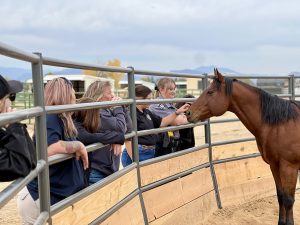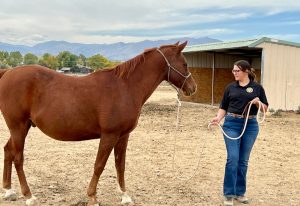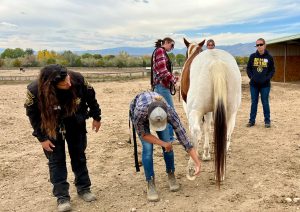At Colorado Horse Rescue (CHR), we believe in supporting not only the horses in our care but also those beyond our gates. Recently, we welcomed local law enforcement officers to CHR, sharing with them key insights and practices in equine healthcare and welfare. This training equips officers to better assess and respond to cases involving equine welfare in the field, expanding CHR’s mission to advocate for every horse in need.
Like any animal, horses have specific care needs that impact their health, happiness, and lifespan. Responsible care for equines covers a broad range of topics, including body condition scoring, balanced nutrition, and preventative healthcare. Here’s a look at some of the fundamentals that help ensure these animals remain healthy and active.

Body Condition and Top Line Scoring
One core component of assessing a horse’s health is the Body Condition Score (BCS), a hands-on evaluation method developed by Don Henneke. This approach uses six key body regions to assess a horse’s fat levels, crucial for understanding overall wellness and identifying any potential health issues. Top Line Evaluation Scoring (TES) is an additional measure that helps evaluate muscle tone, providing insights into the horse’s nutritional adequacy and exercise regimen.

Feeding and Nutritional Needs
Forage is the foundation of a healthy diet for horses, with most requiring around 1.5 – 3% of their body weight in hay daily. This comes to about 20lbs of hay per day for a 1000lb horse. Choices between grass hay and alfalfa can make a difference depending on the horse’s needs, as alfalfa is nutrient-dense and beneficial for horses needing additional calories. At CHR, we emphasize quality and consistency in feeding, whether it’s a hay-based diet or supplemented with grain, hay pellets, or beet pulp for horses with specific dietary needs.

Shelter, Fencing, and Housing Standards
Safe and comfortable shelter is paramount. For safety and wellness purposes, CHR recommends providing a 12×12 foot stall per standard-size equine in a barn with turnout or pasture, or a three-sided run-in shelter with a recommended 12×12 feet per equine in pasture.
In terms of fencing, CHR advocates for electric fencing and/or concrete-anchored wood post and stretched horse mesh fencing. Poorly maintained or dangerous fencing can pose significant risks, so regular monitoring is crucial to prevent accidents.

Preventative and Emergency Vet Care
Regular veterinary exams help catch and address issues before they become critical. Preventative care includes dental maintenance—horses’ teeth grow continuously and can cause issues without routine attention. Farrier visits every 6-8 weeks also prevent hoof-related complications. During the session with law enforcement, CHR provided guidance on emergency protocols, highlighting the importance of recognizing signs of distress or illness and assessing the severity of injuries to ensure prompt veterinary care when necessary.

A Broader Mission: Supporting Law Enforcement in Equine Welfare
CHR’s recent law enforcement training is part of a broader effort to support equine welfare at a community level. Officers left CHR equipped with a deeper understanding of assessing body condition, identifying poor living conditions, and recognizing urgent care needs. We’re hopeful that this initiative will enable quicker, more effective responses to cases of neglect or abuse, improving outcomes for horses across the region.
Our work with law enforcement is just one way CHR strives to create a better world for horses. By spreading knowledge and resources, we’re building a future where horses, both inside and outside our gates, can live healthy, happy lives. We invite our community to join us in advocating for these incredible animals, ensuring they receive the care and respect they deserve.